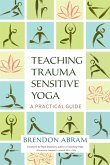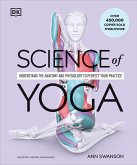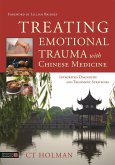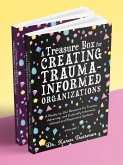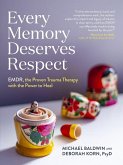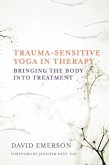- Broschiertes Buch
- Merkliste
- Auf die Merkliste
- Bewerten Bewerten
- Teilen
- Produkt teilen
- Produkterinnerung
- Produkterinnerung
Trauma-sensitive yoga is a body-based intervention for treating emotional responses to trauma and post-traumatic stress disorder. This book explains why yoga is a useful approach for trauma therapy and shows how to use this method in one-to-one and group settings. It also includes useful examples of non-triggering asanas and breathing exercises.
Andere Kunden interessierten sich auch für
![Teaching Trauma-Sensitive Yoga: A Practical Guide Teaching Trauma-Sensitive Yoga: A Practical Guide]() Brendon AbramTeaching Trauma-Sensitive Yoga: A Practical Guide20,99 €
Brendon AbramTeaching Trauma-Sensitive Yoga: A Practical Guide20,99 €![The Energy to Heal The Energy to Heal]() Lauren WalkerThe Energy to Heal20,99 €
Lauren WalkerThe Energy to Heal20,99 €![Science of Yoga Science of Yoga]() Ann SwansonScience of Yoga22,99 €
Ann SwansonScience of Yoga22,99 €![Treating Emotional Trauma with Chinese Medicine Treating Emotional Trauma with Chinese Medicine]() CT HolmanTreating Emotional Trauma with Chinese Medicine60,99 €
CT HolmanTreating Emotional Trauma with Chinese Medicine60,99 €![A Treasure Box for Creating Trauma-Informed Organizations A Treasure Box for Creating Trauma-Informed Organizations]() Treisman, Dr. Karen, Clinical Psychologist, trainer, & authorA Treasure Box for Creating Trauma-Informed Organizations112,99 €
Treisman, Dr. Karen, Clinical Psychologist, trainer, & authorA Treasure Box for Creating Trauma-Informed Organizations112,99 €![Every Memory Deserves Respect Every Memory Deserves Respect]() Deborah KornEvery Memory Deserves Respect13,99 €
Deborah KornEvery Memory Deserves Respect13,99 €![Trauma-Sensitive Yoga in Therapy: Bringing the Body Into Treatment Trauma-Sensitive Yoga in Therapy: Bringing the Body Into Treatment]() David EmersonTrauma-Sensitive Yoga in Therapy: Bringing the Body Into Treatment33,99 €
David EmersonTrauma-Sensitive Yoga in Therapy: Bringing the Body Into Treatment33,99 €-
-
-
Trauma-sensitive yoga is a body-based intervention for treating emotional responses to trauma and post-traumatic stress disorder. This book explains why yoga is a useful approach for trauma therapy and shows how to use this method in one-to-one and group settings. It also includes useful examples of non-triggering asanas and breathing exercises.
Hinweis: Dieser Artikel kann nur an eine deutsche Lieferadresse ausgeliefert werden.
Hinweis: Dieser Artikel kann nur an eine deutsche Lieferadresse ausgeliefert werden.
Produktdetails
- Produktdetails
- Verlag: Jessica Kingsley Publishers
- Seitenzahl: 304
- Erscheinungstermin: 21. Juni 2017
- Englisch
- Abmessung: 229mm x 155mm x 17mm
- Gewicht: 440g
- ISBN-13: 9781848193468
- ISBN-10: 1848193467
- Artikelnr.: 47365762
- Herstellerkennzeichnung
- Libri GmbH
- Europaallee 1
- 36244 Bad Hersfeld
- gpsr@libri.de
- Verlag: Jessica Kingsley Publishers
- Seitenzahl: 304
- Erscheinungstermin: 21. Juni 2017
- Englisch
- Abmessung: 229mm x 155mm x 17mm
- Gewicht: 440g
- ISBN-13: 9781848193468
- ISBN-10: 1848193467
- Artikelnr.: 47365762
- Herstellerkennzeichnung
- Libri GmbH
- Europaallee 1
- 36244 Bad Hersfeld
- gpsr@libri.de
Dagmar Härle. Foreword by David Emerson.
Acknowledgements. Foreword by David Emerson. Introduction. Part One. West -
Psychotraumatology. 1. The Event. 2. The Impact. 2.1. Post-traumatic Stress
Disorder (PTSD). 2.2. Complex Post-traumatic Stress Disorders, Attachment
Trauma, and Developmental Trauma. 2.3. Dissociation. 3. Why Doesn't It Stop
When It's Over? 3.1. The Hierarchy of Information Processing. 3.2. How Can
Traumatic Experiences Be Integrated. 3.3. How Do We Reach the Subcortical
Brain Structures? 3.4 Polyvagal Theory. 3.5. Top Down Versus Bottom Up.
3.6. The Inner World of the Body - The Sixth Sense. 4. What to Do? 4.1.
Stabilization or Exposure Therapy? 4.2. First Develop a Good Relationship?
4.3. The Third Space. Part Two. East - Yoga: The Connection Between Body
and Spirit. 5. Yoga is More than Asanas. 5.1. History and Principles. 5.2.
The Paths to Liberation. 5.3. The Eightfold Path of Raja Yoga. 6. "Work In"
- Hatha Yoga. 7. The Tools of a Yogi. 7.1. Asana. 7.2. Pranayama. 7.3.
Mindfulness. Part Three. West Studies East: Research. 8. Yoga Helps! 8.1.
Yoga Influences Neurotransmitters. 8.2. Does Yoga Help Trauma Clients? 8.3.
Does Yoga Replace Trauma Therapy? 9. Which Components of Yoga are
Effective? 9.1. The Rhythm Does It. 9.2. The Breath Does It. 9.3. Asanas or
Pranayama? 9.4. Mindfulness as an Effect Factor. 9.5. Summary and
Conclusions. Part Four. How Does Yoga Become Part Of Trauma Therapy? 10.
The Method. 10.1. Basic Preconditions for Trauma Therapy. 10.2. Principles
for a Body-Oriented Approach. 11. Possible Practice Settings. 11.1.
Trauma-Sensitive Yoga in the Group. 11.2. TSY at the Beginning and/or End
of a Therapy Session. 11.3. Planning and Developing a Yoga Program. 11.4.
Incorporating TSY into the Trauma Therapy. 11.5. Planning the Therapy. 12.
Guidance for Instructors. 12.1. Tone of Voice. 12.2. Pace and Timing of
Speech. 12.3. Processing of Instructions. 12.4. Staying in Contact. 12.5.
Keeping the Focus on the Body. 12.6. Emphasis on Choices and Freedom in
Decision-making. 12.7. Corrections. 12.8. The Language of Empowerment.
12.9. Wavelike Instruction and Breaks. 12.10. Relationshop and Mirroring.
12.11. Interoceptive Language. Part Five. Practice. 13. Asanas. 13.1.
Seated Poses. 13.2. Standing Poses. 14. Breathing. 14.1. Breating in
Anatomical Terms. 14.2. Breathing in Practical Terms. 14.3. Goals of Breath
Control. 14.4. Pranayama Practice. 14.5. How Do I Introduce Working with
the Breath? 14.6. Pranayama Exercices. 15. Mindfulness. 15.1. Effective
Factors. 15.2. Goals of Mindfulness Practice. 15.3. Being Non-Judgemental.
15.4. What Does Non-Mindfulness Actually Look Like? Part Six. Achieving
Therapeutic Goals with Trauma Sensitive Yoga. 16. Overview of Therapy Goals
and Trauma-Sensitive Yoga. 17. Psychoeducation. 18. Practice and Case
Examples. 18.1. Building Resources. 18.2. Affect Regulation and Control.
18.3. Learning Differentiation. 18.4. Flexibility in Posture and Movement.
18.5. Impulses and Interrupted Defensive Movement. 18.6. Relaxation. 18.7.
Exposure and Habituation in Body-oriented Therapy. 18.8. Relationship on an
Equal Basis. 18.9. Dissociation and Flashback: Here-and-Now Experiences.
18.10. Changing Concepts of the Self: Empowerment and Self-Esteem. 18.11.
Reducing States of Tension in the Body. Concluding Thoughts. Appendices.
Bibliography. Index.
Psychotraumatology. 1. The Event. 2. The Impact. 2.1. Post-traumatic Stress
Disorder (PTSD). 2.2. Complex Post-traumatic Stress Disorders, Attachment
Trauma, and Developmental Trauma. 2.3. Dissociation. 3. Why Doesn't It Stop
When It's Over? 3.1. The Hierarchy of Information Processing. 3.2. How Can
Traumatic Experiences Be Integrated. 3.3. How Do We Reach the Subcortical
Brain Structures? 3.4 Polyvagal Theory. 3.5. Top Down Versus Bottom Up.
3.6. The Inner World of the Body - The Sixth Sense. 4. What to Do? 4.1.
Stabilization or Exposure Therapy? 4.2. First Develop a Good Relationship?
4.3. The Third Space. Part Two. East - Yoga: The Connection Between Body
and Spirit. 5. Yoga is More than Asanas. 5.1. History and Principles. 5.2.
The Paths to Liberation. 5.3. The Eightfold Path of Raja Yoga. 6. "Work In"
- Hatha Yoga. 7. The Tools of a Yogi. 7.1. Asana. 7.2. Pranayama. 7.3.
Mindfulness. Part Three. West Studies East: Research. 8. Yoga Helps! 8.1.
Yoga Influences Neurotransmitters. 8.2. Does Yoga Help Trauma Clients? 8.3.
Does Yoga Replace Trauma Therapy? 9. Which Components of Yoga are
Effective? 9.1. The Rhythm Does It. 9.2. The Breath Does It. 9.3. Asanas or
Pranayama? 9.4. Mindfulness as an Effect Factor. 9.5. Summary and
Conclusions. Part Four. How Does Yoga Become Part Of Trauma Therapy? 10.
The Method. 10.1. Basic Preconditions for Trauma Therapy. 10.2. Principles
for a Body-Oriented Approach. 11. Possible Practice Settings. 11.1.
Trauma-Sensitive Yoga in the Group. 11.2. TSY at the Beginning and/or End
of a Therapy Session. 11.3. Planning and Developing a Yoga Program. 11.4.
Incorporating TSY into the Trauma Therapy. 11.5. Planning the Therapy. 12.
Guidance for Instructors. 12.1. Tone of Voice. 12.2. Pace and Timing of
Speech. 12.3. Processing of Instructions. 12.4. Staying in Contact. 12.5.
Keeping the Focus on the Body. 12.6. Emphasis on Choices and Freedom in
Decision-making. 12.7. Corrections. 12.8. The Language of Empowerment.
12.9. Wavelike Instruction and Breaks. 12.10. Relationshop and Mirroring.
12.11. Interoceptive Language. Part Five. Practice. 13. Asanas. 13.1.
Seated Poses. 13.2. Standing Poses. 14. Breathing. 14.1. Breating in
Anatomical Terms. 14.2. Breathing in Practical Terms. 14.3. Goals of Breath
Control. 14.4. Pranayama Practice. 14.5. How Do I Introduce Working with
the Breath? 14.6. Pranayama Exercices. 15. Mindfulness. 15.1. Effective
Factors. 15.2. Goals of Mindfulness Practice. 15.3. Being Non-Judgemental.
15.4. What Does Non-Mindfulness Actually Look Like? Part Six. Achieving
Therapeutic Goals with Trauma Sensitive Yoga. 16. Overview of Therapy Goals
and Trauma-Sensitive Yoga. 17. Psychoeducation. 18. Practice and Case
Examples. 18.1. Building Resources. 18.2. Affect Regulation and Control.
18.3. Learning Differentiation. 18.4. Flexibility in Posture and Movement.
18.5. Impulses and Interrupted Defensive Movement. 18.6. Relaxation. 18.7.
Exposure and Habituation in Body-oriented Therapy. 18.8. Relationship on an
Equal Basis. 18.9. Dissociation and Flashback: Here-and-Now Experiences.
18.10. Changing Concepts of the Self: Empowerment and Self-Esteem. 18.11.
Reducing States of Tension in the Body. Concluding Thoughts. Appendices.
Bibliography. Index.
Acknowledgements. Foreword by David Emerson. Introduction. Part One. West -
Psychotraumatology. 1. The Event. 2. The Impact. 2.1. Post-traumatic Stress
Disorder (PTSD). 2.2. Complex Post-traumatic Stress Disorders, Attachment
Trauma, and Developmental Trauma. 2.3. Dissociation. 3. Why Doesn't It Stop
When It's Over? 3.1. The Hierarchy of Information Processing. 3.2. How Can
Traumatic Experiences Be Integrated. 3.3. How Do We Reach the Subcortical
Brain Structures? 3.4 Polyvagal Theory. 3.5. Top Down Versus Bottom Up.
3.6. The Inner World of the Body - The Sixth Sense. 4. What to Do? 4.1.
Stabilization or Exposure Therapy? 4.2. First Develop a Good Relationship?
4.3. The Third Space. Part Two. East - Yoga: The Connection Between Body
and Spirit. 5. Yoga is More than Asanas. 5.1. History and Principles. 5.2.
The Paths to Liberation. 5.3. The Eightfold Path of Raja Yoga. 6. "Work In"
- Hatha Yoga. 7. The Tools of a Yogi. 7.1. Asana. 7.2. Pranayama. 7.3.
Mindfulness. Part Three. West Studies East: Research. 8. Yoga Helps! 8.1.
Yoga Influences Neurotransmitters. 8.2. Does Yoga Help Trauma Clients? 8.3.
Does Yoga Replace Trauma Therapy? 9. Which Components of Yoga are
Effective? 9.1. The Rhythm Does It. 9.2. The Breath Does It. 9.3. Asanas or
Pranayama? 9.4. Mindfulness as an Effect Factor. 9.5. Summary and
Conclusions. Part Four. How Does Yoga Become Part Of Trauma Therapy? 10.
The Method. 10.1. Basic Preconditions for Trauma Therapy. 10.2. Principles
for a Body-Oriented Approach. 11. Possible Practice Settings. 11.1.
Trauma-Sensitive Yoga in the Group. 11.2. TSY at the Beginning and/or End
of a Therapy Session. 11.3. Planning and Developing a Yoga Program. 11.4.
Incorporating TSY into the Trauma Therapy. 11.5. Planning the Therapy. 12.
Guidance for Instructors. 12.1. Tone of Voice. 12.2. Pace and Timing of
Speech. 12.3. Processing of Instructions. 12.4. Staying in Contact. 12.5.
Keeping the Focus on the Body. 12.6. Emphasis on Choices and Freedom in
Decision-making. 12.7. Corrections. 12.8. The Language of Empowerment.
12.9. Wavelike Instruction and Breaks. 12.10. Relationshop and Mirroring.
12.11. Interoceptive Language. Part Five. Practice. 13. Asanas. 13.1.
Seated Poses. 13.2. Standing Poses. 14. Breathing. 14.1. Breating in
Anatomical Terms. 14.2. Breathing in Practical Terms. 14.3. Goals of Breath
Control. 14.4. Pranayama Practice. 14.5. How Do I Introduce Working with
the Breath? 14.6. Pranayama Exercices. 15. Mindfulness. 15.1. Effective
Factors. 15.2. Goals of Mindfulness Practice. 15.3. Being Non-Judgemental.
15.4. What Does Non-Mindfulness Actually Look Like? Part Six. Achieving
Therapeutic Goals with Trauma Sensitive Yoga. 16. Overview of Therapy Goals
and Trauma-Sensitive Yoga. 17. Psychoeducation. 18. Practice and Case
Examples. 18.1. Building Resources. 18.2. Affect Regulation and Control.
18.3. Learning Differentiation. 18.4. Flexibility in Posture and Movement.
18.5. Impulses and Interrupted Defensive Movement. 18.6. Relaxation. 18.7.
Exposure and Habituation in Body-oriented Therapy. 18.8. Relationship on an
Equal Basis. 18.9. Dissociation and Flashback: Here-and-Now Experiences.
18.10. Changing Concepts of the Self: Empowerment and Self-Esteem. 18.11.
Reducing States of Tension in the Body. Concluding Thoughts. Appendices.
Bibliography. Index.
Psychotraumatology. 1. The Event. 2. The Impact. 2.1. Post-traumatic Stress
Disorder (PTSD). 2.2. Complex Post-traumatic Stress Disorders, Attachment
Trauma, and Developmental Trauma. 2.3. Dissociation. 3. Why Doesn't It Stop
When It's Over? 3.1. The Hierarchy of Information Processing. 3.2. How Can
Traumatic Experiences Be Integrated. 3.3. How Do We Reach the Subcortical
Brain Structures? 3.4 Polyvagal Theory. 3.5. Top Down Versus Bottom Up.
3.6. The Inner World of the Body - The Sixth Sense. 4. What to Do? 4.1.
Stabilization or Exposure Therapy? 4.2. First Develop a Good Relationship?
4.3. The Third Space. Part Two. East - Yoga: The Connection Between Body
and Spirit. 5. Yoga is More than Asanas. 5.1. History and Principles. 5.2.
The Paths to Liberation. 5.3. The Eightfold Path of Raja Yoga. 6. "Work In"
- Hatha Yoga. 7. The Tools of a Yogi. 7.1. Asana. 7.2. Pranayama. 7.3.
Mindfulness. Part Three. West Studies East: Research. 8. Yoga Helps! 8.1.
Yoga Influences Neurotransmitters. 8.2. Does Yoga Help Trauma Clients? 8.3.
Does Yoga Replace Trauma Therapy? 9. Which Components of Yoga are
Effective? 9.1. The Rhythm Does It. 9.2. The Breath Does It. 9.3. Asanas or
Pranayama? 9.4. Mindfulness as an Effect Factor. 9.5. Summary and
Conclusions. Part Four. How Does Yoga Become Part Of Trauma Therapy? 10.
The Method. 10.1. Basic Preconditions for Trauma Therapy. 10.2. Principles
for a Body-Oriented Approach. 11. Possible Practice Settings. 11.1.
Trauma-Sensitive Yoga in the Group. 11.2. TSY at the Beginning and/or End
of a Therapy Session. 11.3. Planning and Developing a Yoga Program. 11.4.
Incorporating TSY into the Trauma Therapy. 11.5. Planning the Therapy. 12.
Guidance for Instructors. 12.1. Tone of Voice. 12.2. Pace and Timing of
Speech. 12.3. Processing of Instructions. 12.4. Staying in Contact. 12.5.
Keeping the Focus on the Body. 12.6. Emphasis on Choices and Freedom in
Decision-making. 12.7. Corrections. 12.8. The Language of Empowerment.
12.9. Wavelike Instruction and Breaks. 12.10. Relationshop and Mirroring.
12.11. Interoceptive Language. Part Five. Practice. 13. Asanas. 13.1.
Seated Poses. 13.2. Standing Poses. 14. Breathing. 14.1. Breating in
Anatomical Terms. 14.2. Breathing in Practical Terms. 14.3. Goals of Breath
Control. 14.4. Pranayama Practice. 14.5. How Do I Introduce Working with
the Breath? 14.6. Pranayama Exercices. 15. Mindfulness. 15.1. Effective
Factors. 15.2. Goals of Mindfulness Practice. 15.3. Being Non-Judgemental.
15.4. What Does Non-Mindfulness Actually Look Like? Part Six. Achieving
Therapeutic Goals with Trauma Sensitive Yoga. 16. Overview of Therapy Goals
and Trauma-Sensitive Yoga. 17. Psychoeducation. 18. Practice and Case
Examples. 18.1. Building Resources. 18.2. Affect Regulation and Control.
18.3. Learning Differentiation. 18.4. Flexibility in Posture and Movement.
18.5. Impulses and Interrupted Defensive Movement. 18.6. Relaxation. 18.7.
Exposure and Habituation in Body-oriented Therapy. 18.8. Relationship on an
Equal Basis. 18.9. Dissociation and Flashback: Here-and-Now Experiences.
18.10. Changing Concepts of the Self: Empowerment and Self-Esteem. 18.11.
Reducing States of Tension in the Body. Concluding Thoughts. Appendices.
Bibliography. Index.


